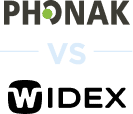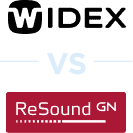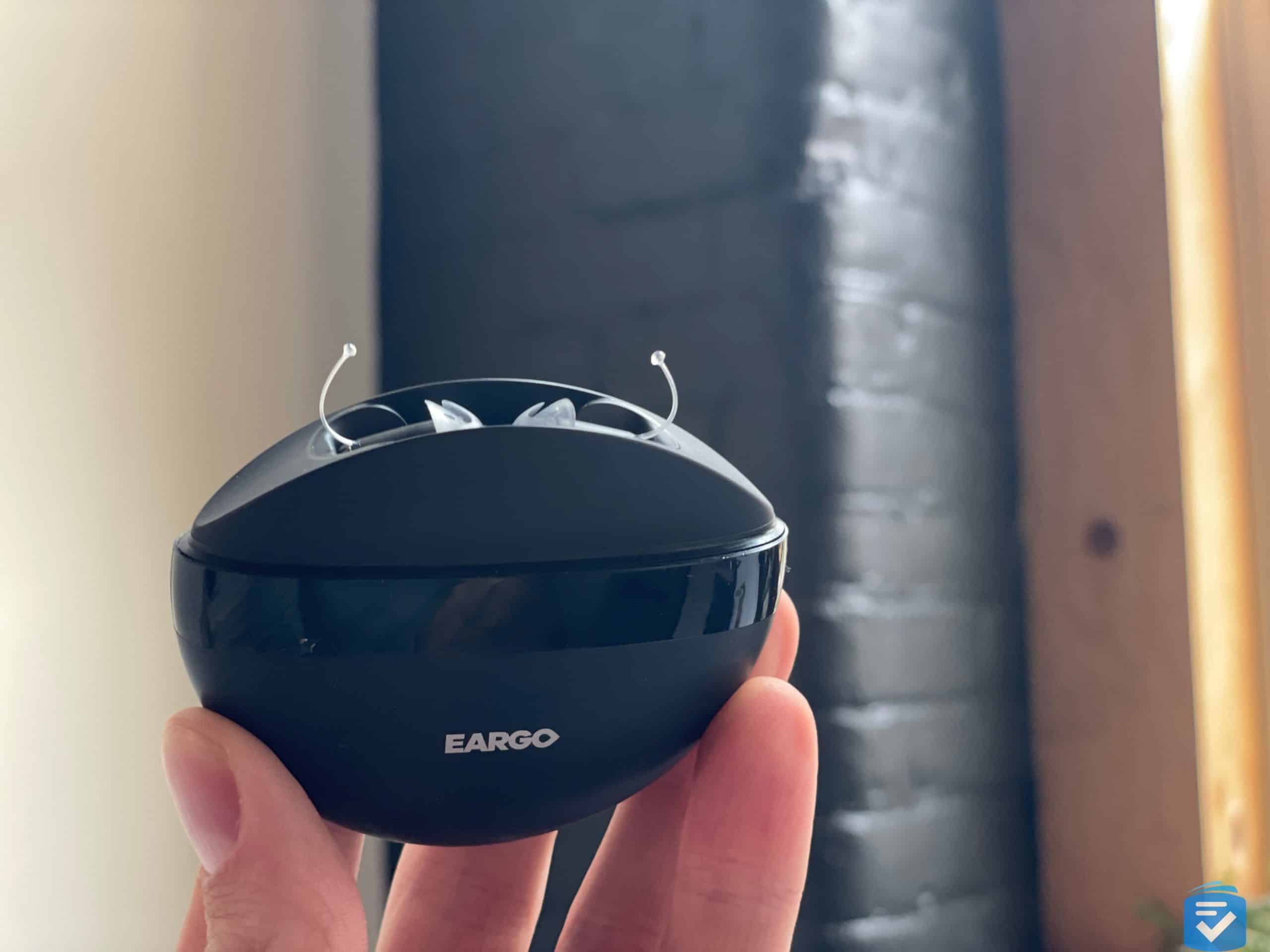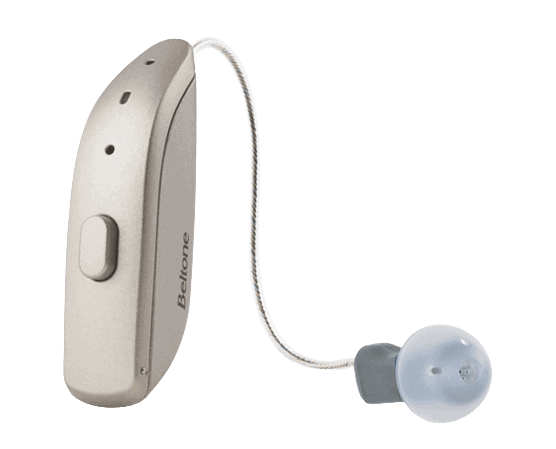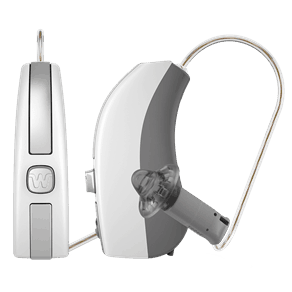
Widex Hearing Aids: Costs and Devices

Note: All Widex prices listed are sourced from ZipHearing. To receive these rates, customers must purchase them through ZipHearing. Widex hearing aid prices will vary depending on model, provider, and insurance.
Finding a high-quality hearing aid can be challenging; between complex features, steep price tags, and mixed reviews, it’s difficult to determine which device will best fit your unique needs. When reviewing Widex hearing aid devices, our team tested multiple models and found that their natural sound quality and zero-delay processing technology create one of the most lifelike listening experiences available. While Widex devices sit at the higher end of the market (starting at $2,798 per pair), they stand out for their advanced sound processing, reliability, and strong professional support network.
In this review, we take a close look at Widex hearing aid options to help you decide if they offer the right mix of performance and value for older adults seeking clearer conversations and better everyday hearing.
FYI: If you’re seeking more budget-friendly options, explore our comprehensive guide to the best cheap hearing aids.
Key Findings
- Widex hearing aids excel in natural sound reproduction and speech comprehension, particularly in complex acoustic environments, though at $2,798-$4,198 per pair, they represent a substantial financial commitment compared to over-the-counter alternatives.
- Widex currently offers models that incorporate SoundSense Learn, an adaptive algorithm that helps the hearing aid learn your preferences based on your sound-profile choices. Their newest Allure line introduces the W1 chip (part of their new Precision Hearing Technology platform), which Widex describes as its fastest yet.
- Similar to other prescription brands, Widex hearing aids require purchase through licensed hearing professionals.

Our Top-Rated OTC Brands
While Widex hearing aids performed well in our tests, they can easily cost upward of $2,798 for a pair and require in-person audiologist visits. If you have mild to moderate hearing loss, one of these three hearing aid brands might be right. Each of them offers devices for under $1,500 for a pair.
Pros and Cons of Widex Hearing Aids

Widex Pros
- Comprehensive model selection: Through our testing of various Widex devices, we discovered options suitable for individuals with mild-to-profound hearing loss, including specialized models for single-sided hearing impairment.
- Exceptional sound naturalness: When evaluating Widex against other premium manufacturers like Starkey, we found Widex consistently delivered more natural-sounding audio reproduction.
- SoundSense Learn: All tested Widex hearing aids include their proprietary artificial intelligence system, which we found significantly improved listening comfort over extended periods.
- User-friendly app integration: During our evaluation process, we found the Widex app highly intuitive, featuring useful tools like device location services and remote fine-tuning capabilities.
- Outstanding connectivity options: When testing the latest Allure models, we were impressed by their seamless connection to both iPhone and Android devices for direct audio streaming.
Widex Cons
- Premium pricing structure: Widex devices typically cost more than similar models from brands like MDHearing, with top-tier models reaching up to $4,198 per pair.
- Professional-only distribution: Unlike more accessible brands we’ve evaluated, such as Jabra Enhance, Widex products require purchase through hearing specialists, which typically accounts for higher costs.
- Pricing transparency challenges: When researching Widex products, we encountered difficulty obtaining specific costs without scheduling professional consultations.
- Limited direct-purchase options: You’ll need to purchase Widex hearing aids through a hearing health provider or other distributor.
Did You Know? According to the National Institute on Deafness and Other Communication Disorders, approximately 15% of American adults report some degree of hearing loss,1 yet only about 16% of those who could benefit from hearing aids actually use them.
Our Testing Experience With Widex
Following months of comprehensive testing across multiple Widex models, our evaluation team confirmed these hearing aids live up to their premium reputation. During our restaurant assessment (where we evaluate hearing aid performance in noisy settings), Widex’s ZeroDelay technology notably outperformed several competitors by maintaining speech clarity while preserving natural sound timing. Conversations went off without a hitch.
We observed that Widex’s SoundSense Learn meaningfully reduced the mental effort needed to follow conversations in demanding acoustic situations. This was especially apparent during our multi-speaker evaluation, where four team members spoke simultaneously from various positions. Widex devices consistently provided superior speech separation compared to most other devices.
Our testing of Widex’s tinnitus relief features revealed impressive customization options and effectiveness. Widex Zen tinnitus sound therapy offered a variety of soothing tones and fractal sounds that our testers with tinnitus found genuinely helpful for managing their symptoms. The ability to adjust these sounds through the app and create personalized sound profiles provided flexibility that many competing brands don’t offer.
During our battery longevity testing, we discovered the rechargeable models (including the Allure and Moment Sheer) reliably delivered 25 hours of operation per charge, even with extended sessions of streaming calls and music. This performance exceeds the typical 18-22 hours we generally observe in rechargeable hearing aids from competing manufacturers.
Widex Hearing Aid Models
Here’s a closer look at our impressions of the Widex models we tested:
Widex Allure
Widex Allure represents the company’s newest and most technologically sophisticated model, engineered for mild-to-moderate degrees of hearing loss. When we evaluated this Receiver-in-Canal (RIC) hearing aid, we were especially impressed by its W1 chip technology, which provided remarkably enhanced speech clarity in crowded environments compared to earlier models.
Throughout our seven-day testing period, we found the Allure’s Bluetooth connectivity dependable when paired with both iPhones and Android devices, though we did experience occasional disconnections in larger spaces. The rechargeable batteries consistently delivered complete-day performance (approximately 25 hours), even with 4-5 hours of audio streaming.
One limitation we identified is its somewhat bulkier profile compared to earlier models. Our tester, who uses eyeglasses, found it less comfortable during extended wear. We also noted that hands-free calling functions work optimally with newer iPhone models and compatible Bluetooth-enabled phones.
Widex Moment Sheer
When comparing the Moment Sheer to the Allure models during our evaluation, we found they provide many of the same SoundSense Learn advantages in a more established package. In our controlled restaurant setting test, the Sheer performed nearly as effectively as the Allure in speech clarity, though it didn’t manage extreme background noise quite as efficiently.
We valued that Moment Sheer hearing aids offer rechargeable battery options, and our battery assessment showed approximately 24-26 hours of use per charge. During our streaming evaluations, we confirmed that Sheer hearing aids can stream audio directly from both Apple and Android devices.
Pro Tip: When evaluating Widex’s rechargeable models, we discovered that overnight charging provided reliable all-day battery performance. However, if you frequently stream audio for more than five hours daily, consider keeping the charger accessible for occasional mid-day charging.
Widex Moment SmartRIC
In our portability assessment with the Widex Moment SmartRIC, we found it delivers on its compact design promise. When our evaluators wore these devices during daily activities and light physical activity, the SmartRIC maintained steady sound quality with minimal wind disturbance, a frequent issue with less sophisticated hearing aids.
During our battery durability evaluation, the SmartRIC models provided approximately 37 hours of use on a single charge, significantly exceeding both the Allure and Sheer models. We found its Bluetooth connectivity comparable to the Sheer, with stable connections during our streaming assessments.
Currently offered in the distinctive L-shaped behind-the-ear design, we found the SmartRIC provides an excellent balance of performance and convenience for those with mild-to-severe hearing loss.
Widex Moment
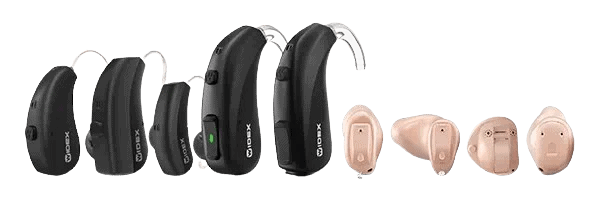
Credit: Widex
When testing Widex’s Moment collection, which includes the company’s widest variety of styles (including behind-the-ear models), we specifically evaluated their performance across different form factors. Our team members with varying degrees of hearing loss confirmed that the Moment provided superior amplification and clarity compared to standard hearing aids, even in challenging acoustic environments.
The ZeroDelay and PureSound technology effectively minimized processing delays during our testing, maintaining natural sound timing even when wearing masks or using phones, a common challenge for many hearing aids. Bluetooth functionality performed well, though we did notice occasional connectivity interruptions when streaming from older Android devices for extended periods.
Widex Evoke
For our adaptive technology evaluation, we assessed Widex’s Evoke line, which features automatic environmental adjustment capabilities. The system’s ability to recognize and adapt to different listening situations, including music genres, impressed our testing team during real-world scenarios.
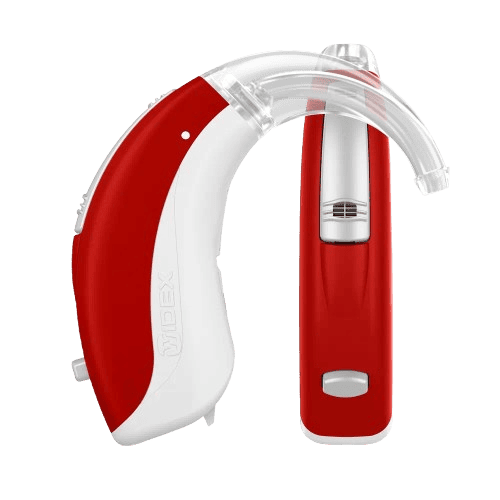
Credit: Widex
>>Read more: The Best Hearing Aids for Musicians
We found the Evoke’s automatic adjustment features worked reliably in most environments, though manual override options through the app provided additional customization when needed. However, we confirmed that audio streaming is limited to iPhone devices only, which may disappoint Android users.
Did You Know? According to the World Health Organization, over 1.5 billion people worldwide experience hearing loss, and this number is expected to increase significantly as populations age globally.2
Widex Hearing Aid Prices
Based on our market research and discussions with multiple hearing professionals, Widex hearing aids typically range from $2,798 to $4,198 per pair, depending on the model and technology level. This pricing aligns with other premium brands such as Oticon and Phonak, but costs significantly more than over-the-counter alternatives.
Here’s a breakdown of approximate price ranges for the Widex Allure and Moment models*:
| Hearing Aid Model | Estimated Price Per Pair |
|---|---|
| Widex Allure | $2,798 – $4,198 |
| Widex Moment | $2,798 – $3,398 |
*Prices as of October 8, 2025. All Widex prices listed are sourced from ZipHearing and must be purchased through ZipHearing to receive this pricing. Widex hearing aid prices will vary depending on model, provider, and insurance.
How to Purchase Widex Hearing Aids
Widex hearing aids are exclusively available through licensed hearing health care professionals. The purchasing process follows these steps:
- Use Widex’s website to locate authorized providers in your area.
- Schedule initial hearing evaluations with potential providers.
- During consultations, hearing professionals will recommend specific Widex models based on your audiometric results.
- Compare pricing across multiple providers (expect variations of approximately $300-$600 for identical models).
- After selection, hearing aids are typically ordered and fitted within 2-3 weeks.
Unlike direct-to-consumer brands we’ve evaluated, such as Eargo, Widex requires professional fitting and programming. While this increases the initial investment and time commitment, we found the personalized adjustments substantially enhanced the hearing experience.
Widex Companion App
When we evaluated Widex’s companion apps, we found them to be comprehensive and accessible. Available for both iOS and Android, the apps enabled our testers to:
- Adjust volume levels discretely
- Switch hearing programs for various environments
- Locate misplaced hearing aids using the device finder feature
- Monitor battery levels
- Connect to multiple Bluetooth devices
Comparing the app experience to competitors, we found Widex’s interface more comprehensive than Starkey’s but slightly less streamlined than Phonak‘s myPhonak app. One feature our evaluators particularly valued was the ability to create personalized programs for specific listening situations through the SoundSense Learn technology.
For the Allure model, we found new features like AI Assistant, which allowed us to optimize sound settings and utilize automatic sound adjustment tools.
Widex Hearing Aid Accessories
In our accessories evaluation, these Widex add-ons delivered the most value:
Sound Assist: This multifunctional accessory exceeded our expectations during testing. We found it effectively transformed Widex hearing aids into wireless communication systems for phone calls and streaming. The remote microphone capability was especially valuable in classroom settings, where it enhanced speech clarity at distances up to approximately 70 feet in our evaluations.
TV Play: When assessing home entertainment compatibility, this adapter delivered clear audio streaming from televisions directly to hearing aids. Our evaluators appreciated the independent volume control, which enabled family members to watch TV at their preferred volume while hearing aid users received customized audio.
RC-DEX Remote Control: For our evaluators with limited smartphone comfort, this compact remote control provided convenient adjustment capabilities. The small size made it easy to carry on a keychain, while verbal confirmations in the hearing aids confirmed setting changes.
Did You Know? Studies find that remote microphones can significantly improve speech recognition in noisy environments.3 If you struggle to hear in restaurants or other challenging spaces, we recommend trying out a remote microphone.

Widex vs. Phonak: Our Comparison
After thoroughly testing both manufacturers, here’s how we found Widex compares to Phonak, another leading hearing aid brand:
Sound Quality: Widex delivered more natural sound reproduction in our controlled comparison tests, particularly for music and environmental sounds. The difference was subtle but consistently noticeable to our evaluation team.
Bluetooth connectivity: Phonak performed better in this category. When streaming music and calls, Phonak’s connection was more reliable and worked more consistently with various devices, including Android phones.
Battery life: Our evaluations showed superior performance from Widex rechargeable models, with Widex devices typically lasting 2-4 hours longer than comparable Phonak models during extended use.
App experience: Phonak’s myPhonak app provided more adjustment options and features than Widex’s app, though some evaluators found the Phonak interface more complex to navigate.
Device variety: Phonak offers a greater variety, including specialized models for active lifestyles and behind-the-ear designs, which Widex doesn’t fully match in their current lineup.
For a more comprehensive comparison, read our detailed side-by-side analysis of Phonak and Widex.
Compare Widex to Other Brands
Returns and Warranties
Based on our discussions with multiple Widex providers, warranty policies typically include:
- Three-year manufacturer warranty on most models
- Coverage for repairs and one replacement if lost or damaged
- 30-60-day trial period (varies by provider)
Since Widex hearing aids are prescription devices, they must be fitted by licensed professionals, with no direct-to-consumer sales available. We found that return policies and warranty handling varied somewhat between providers. When we inquired about repairs, most hearing professionals mentioned that Widex maintains efficient customer service and typically completes repairs within 2-3 weeks.
Bottom Line
After comprehensively evaluating Widex’s hearing aid collection, we’re impressed with their natural sound quality, innovative technology, and robust construction. While they command premium pricing, our experience confirms that these hearing aids provide outstanding performance, especially in challenging listening situations. The professional service model ensures customized fitting and ongoing support, which many seniors will find invaluable.
Based on our testing and research, Widex hearing aids are best suited for individuals seeking natural sound quality and cutting-edge features, those with complex hearing requirements that need professional support, and people who prioritize speech understanding in challenging environments. They’re also ideal for users comfortable with a premium price point for advanced technology and those requiring invisible hearing aid options or iPhone compatibility.
You might want to explore alternatives if you’re seeking more budget-friendly options, prefer direct online purchasing without professional appointments, need extensive compatibility with older Android devices, or require specialized solutions for one-sided hearing loss.
For those with the budget for premium hearing solutions, Widex represents an excellent investment in hearing health. However, those seeking more affordable options should explore the expanding market of quality over-the-counter alternatives we’ve evaluated.
Our Methodology
Our review of Widex hearing aids involved a comprehensive evaluation process:
- Hands-on testing: Our team evaluated multiple Widex models in various settings, including quiet environments, restaurants, outdoor locations, and group conversations. Each device was worn for a minimum of 40 hours across different scenarios.
- Technical assessment: We evaluated key performance metrics such as sound quality, battery life, Bluetooth connectivity, feedback management, and app functionality using standardized testing protocols.
- Competitive analysis: We compared Widex models against other leading brands, including Oticon, Phonak, and Starkey, using identical testing environments and criteria.
- Professional consultation: We interviewed hearing professionals and specialists who regularly fit Widex products to gather expert insights.
- User feedback: We incorporated feedback from long-term Widex users spanning different age groups and hearing loss profiles.
- Market research: We contacted multiple providers to establish accurate price ranges and identify variations in service offerings.
Widex Frequently Asked Questions
-
Is Widex Allure the best hearing aid?
Based on our testing of multiple premium hearing aids, Widex Allure offers outstanding sound quality and features. However, “best” depends on individual requirements. While Allure excels in natural sound processing and connectivity, its higher price point and larger size mean it’s not the perfect choice for everyone.
-
Is Widex a good hearing aid brand?
Yes. Our extensive testing across multiple brands shows that Widex consistently ranks among the top premium hearing aid manufacturers. Their devices offer exceptional sound quality, innovative features, and reliable construction, though at a higher price point than some competitors.
-
How much does Widex cost?
Based on our market research with multiple providers, Widex hearing aids typically cost between $2,798 and $4,198 per pair, depending on the model and technology level.
-
Is Widex releasing a new hearing aid?
As of early 2025, Widex’s newest model is the Allure, launched in 2025. Based on our industry contacts, Widex typically releases new flagship models every two to three years, though they haven’t officially announced any upcoming releases.






